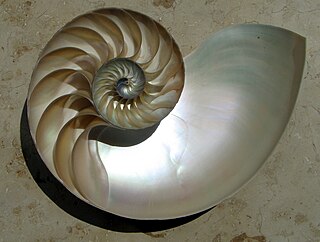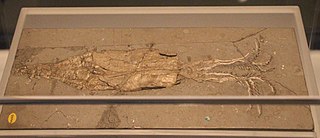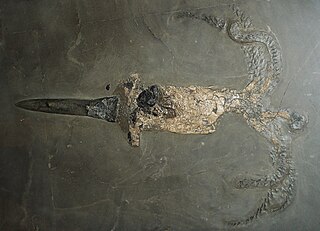
Ammonoids are extinct spiral shelled cephalopods comprising the subclass Ammonoidea. They are more closely related to living coleoids than they are to shelled nautiloids. The earliest ammonoids appeared during the Devonian, with the last species vanishing during or soon after the Cretaceous–Paleogene extinction event. They are often called ammonites, which is most frequently used for members of the order Ammonitida, the only living group of ammonoids from the Jurassic up until their extinction.

Coleoidea or Dibranchiata is one of the two subclasses of cephalopods containing all the various taxa popularly thought of as "soft-bodied" or "shell-less". Unlike its extant sister group Nautiloidea, whose members have a rigid outer shell for protection, the coleoids have at most an internal shell called cuttlebone or gladius that is used for buoyancy or as muscle anchorage. Some species, notably incirrate octopuses, have lost their internal shell altogether, while in some it has been replaced by a chitinous support structure.

Belemnoids are an extinct group of marine cephalopod, very similar in many ways to the modern squid. Like them, the belemnoids possessed an ink sac, but, unlike the squid, they possessed ten arms of roughly equal length, and no tentacles. The name "belemnoid" comes from the Greek word βέλεμνον, belemnon meaning "a dart or arrow" and the Greek word είδος, eidos meaning "form".

Nautiloids are a group of marine cephalopods (Mollusca) which originated in the Late Cambrian and are represented today by the living Nautilus and Allonautilus. Fossil nautiloids are diverse and species rich, with over 2,500 recorded species. They flourished during the early Paleozoic era, when they constituted the main predatory animals. Early in their evolution, nautiloids developed an extraordinary diversity of shell shapes, including coiled morphologies and giant straight-shelled forms (orthocones). No orthoconic and only a handful of coiled species, the nautiluses, survive to the present day.

The phragmocone is the chambered portion of the shell of a cephalopod. It is divided by septa into camerae.

Neocephalopods are a group of cephalopod mollusks that include the coleoids and all extinct species that are more closely related to extant coleoids than to the nautilus. In cladistic terms, it is the total group of Coleoidea. In contrast, the palcephalopoda are defined as the sister group to the neocephalopoda.

Bittacidae is a family of scorpionflies commonly called hangingflies or hanging scorpionflies.

Leptolepis is an extinct genus of stem-teleost fish that lived in what is now Europe and North of Africa during the Jurassic period.

Octopodiformes is a superorder of the subclass Coleoidea, comprising the octopuses and the vampire squid. All living members of Octopodiformes have eight arms, either lacking the two tentacles of squid or modifying the tentacles into thin filaments. Octopodiformes is often considered the crown group of octopuses and vampire squids, including all descendants of their common ancestor. Some authors use the term Vampyropoda for the same general category, though others use "Vampyropoda" to refer to the total group. Another term is Octobranchia, referring to cephalopods without prominent tentacles.

Trachyteuthis is a genus of extinct octopodiform cephalopods, comprising six species: T. hastiformis, T. latipinnis, T. nusplingensis, T. teudopsiformis, T. covacevichi and T. chilensis.

Belemnotheutis is an extinct coleoid cephalopod genus from the middle and upper Jurassic, related to but morphologically distinct from belemnites. Belemnotheutis fossils are some of the best preserved among coleoids. Remains of soft tissue are well-documented in some specimens, even down to microscopic muscle tissue. In 2008, a group of paleontologists even recovered viable ink from ink sacs found in several specimens.

Phragmoteuthis is a genus of extinct coleoid cephalopod known from the late Triassic to the lower Jurassic. Its soft tissue has been preserved; some specimens contain intact ink sacs. It had an internal phragmocone and ten arms.

Acanthoteuthis is a belemnite genus, a squid-like cephalopod with an internal shell from the Late Jurassic Epoch, related to modern coleoids.
The cephalopods have a long geological history, with the first nautiloids found in late Cambrian strata.

Phragmoteuthida is an order of extinct coleoid cephalopods characterized by a fan-like teuthoid pro-ostracum attached to a belemnoid-like phragmocone.

Belemnitida is an extinct order of squid-like cephalopods that existed from the Late Triassic to Late Cretaceous. Unlike squid, belemnites had an internal skeleton that made up the cone. The parts are, from the arms-most to the tip: the tongue-shaped pro-ostracum, the conical phragmocone, and the pointy guard. The calcitic guard is the most common belemnite remain. Belemnites, in life, are thought to have had 10 hooked arms and a pair of fins on the guard. The chitinous hooks were usually no bigger than 5 mm (0.20 in), though a belemnite could have had between 100 and 800 hooks in total, using them to stab and hold onto prey.
Groenlandibelidae is a family of coleoid cephalopods believed to belong to the spirulids.

The Sachrang Formation or "Posidonienschiefer" Formation is a geological formation of southwestern Germany, northern Switzerland, northwestern Austria, southeast Luxembourg and the Netherlands, that spans about 3 million years during the Early Jurassic period. It is known for its detailed fossils, especially sea fauna, listed below. Composed mostly by black shale, the formation is a Lagerstätte, where fossils show exceptional preservation, with a thickness that varies from about 1 m to about 40 m on the Rhine level, being on the main quarry at Holzmaden between 5 and 14 m. Some of the preserved material has been transformed into fossil hydrocarbon Jet, specially wood remains, used for jewelry. The exceptional preservation seen on the Posidonia Shale has been studied since the late 1800s, finding that a cocktail of chemical and environmental factors let to such an impressive conservation of the marine fauna. The most common theory is the changes in the oxygen level, where the different anoxic events of the Toarcian left oxygen-depleted bottom waters, with the biota dying and falling to the bottom without any predator able to eat the dead bodies.
This list of fossil molluscs described in 2022 is a list of new taxa of fossil molluscs that were described during the year 2022, as well as other significant discoveries and events related to molluscan paleontology that occurred in 2022.
This list of fossil molluscs described in 2024 is a list of new taxa of fossil molluscs that were described during the year 2024, as well as other significant discoveries and events related to molluscan paleontology that occurred in 2024.


















